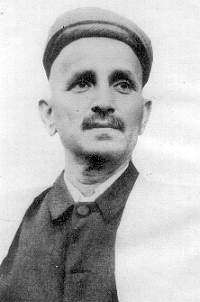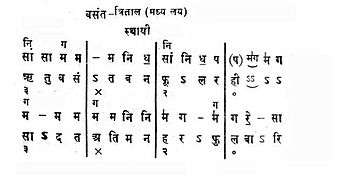Vishnu Narayan Bhatkhande
| Vishnu Narayan Bhatkhande | |
|---|---|
 | |
| Background information | |
| Born |
August 10, 1860 Walkeshwar, Mumbai, India |
| Origin | India |
| Died | September 19, 1936 (aged 76) |
| Genres | |
| Years active | 1875–1935 |
Pandit Vishnu Narayan Bhatkhande (Marathi: विष्णू नारायण भातखंडे)(August 10, 1860 – September 19, 1936) was an Indian musicologist who wrote the first modern treatise on Hindustani classical music (The north Indian variety of Indian classical music), an art which had been propagated earlier for a few centuries mostly through oral traditions. During those earlier times, the art had undergone several changes, rendering the raga grammar documented in scant old texts outdated.[1]
Ragas used to be classified into Raga (male), Ragini (female), and Putra (children). Bhatkhande reclassified them into the currently used Thaat system. He noted that several ragas did not conform to their description in ancient Sanskrit texts. He explained the ragas in an easy-to-understand language and composed several bandishes which explained the grammar of the ragas. He borrowed the idea of lakshan geet from the Carnatic music scholar Venkatamakhin.
Early life
Vishnu Narayan Bhatkhande was born in 1860 in Walkeshwar, Mumbai, Maharashtra. His father had great passion for music which motivated him to study music. At an early age he had mastered singing, veena and flute. He was educated at Elphinstone College in Mumbai and Deccan College in Pune. He graduated with a degree in Law in 1885 and joined the legal profession in 1887. Later he served a short stint as a lawyer in the High Court in Karachi.
During his college days, Bhatkhande began learning sitar playing from Vallabhdas. He later learned vocal music from Raojiba, a Dhrupad singer. He also trained in other aspects of classical music under Belbagkar, Ali Hussain Khan, and Vilayat Hussain Khan. He became a member of Gayan Uttejak Mandali, a musical circle in Mumbai, Maharashtra.
Career
Research in music
Bhatkhande traveled throughout India, meeting with ustads and pandits, and researching music. He began the study of ancient texts such as the Natya Shastra and Sangeet Ratnakara.[2]

After the death of his wife and his daughter, Bhatkhande abandoned his legal practice and devoted the rest of his life to systematizing the prevailing forms of Hindustani music and building on that system a coordinated theory and practice of music. During his travels in India, he spent time in Baroda, Gwalior, and Rampur.In Rampur he was the disciple of legendary Veena Player Ustad Wazir Khan,the descendant of Miyan Tansen.
Bhatkhande's first published work, Swar Malika, was a booklet containing detailed descriptions of all prevalent ragas. In 1909, he published Shri Mallakshaya Sangeetam, in Sanskrit, under the pseudonym 'Chatur-pandit'. To make this cultural heritage accessible to the common man, he published commentary on his own Sanskrit grantha in Marathi over a span of several years; it was published over four volumes bearing the title: Hindustani Sangeet Paddhati. These volumes form today the standard text on Hindustani music, an indispensable starting point for any student of Hindustani Classical Music. His disciple S N Ratanjankar, famous musician Shri. Dilip Kumar Roy, Ratanjankar's disciple K. G. Ginde, S.C.R.Bhatt, Ram Ashrey Jha 'Ramrang', Sumati Mutatkar and Krishna Kumar Kapoor are among the notable scholars who followed in the footsteps of Bhatkhande. His notation system became standard and though later scholars like Pt. V. D. Paluskar, Pandit Vinayakrao Patwardhan and Pt. Omkarnath Thakur introduced their improved versions, it remained a publisher's favorite. It suffered a setback with onset of desktop publishing, which found inserting marks above and below Devanagari text cumbersome; as a result, books carrying compositions yielded to theoretical texts. A recently developed notation system Ome Swarlipi follows the logical structure introduced by Pt. Bhatkhande but uses symbols instead of Devanagari alphabets.
After travelling widely and having discussions with practitioners of various schools, Bhatkhande arranged all the ragas of Hindustani classical music across 10 musical scales, called thaats. Though the thaats do not encompass all possible ragas, they do cover the vast majority, and are a key contribution to Indian musical theory. The thaat structure corresponds to the melakarta system of raga arrangement in Carnatic music, the south Indian variety of Indian classical music.
Bhatkhande wrote all of his works under one of the two pseudonyms, Vishnu Sharma and Chaturpandit.
Institutions
Bhatkhande started schools and colleges in India for systematic teaching of Hindustani music. In 1916, he reorganized the Baroda state music school, and later, with the help of the Maharaja of Gwalior, established the Madhav Music College in Gwalior.
In 1926, Rai Umanath Bali and his nephew Dr. Rai Rajeshwar Bali, then education minister of United Provinces, established Marris College of Music in Lucknow,[3] Bhatkhande preparing the course material. The college was later renamed Bhatkhande College of Hindustani Music, and is now known as Bhatkhande Music Institute (Deemed University). Preparation of that course material was a landmark achievement of Bhatkhande since musical knowledge used to be passed on orally in earlier times from Gurus and Ustads to their disciples.
Bhatkhande prepared the Hindustani Sangeet Kramik Pustak Maalika as a series of textbooks. He also started the tradition of the All India Music Conferences to provide a common platform for discussion between Hindustani and Carnatic classical musicians.
Death
Bhatkhande suffered paralysis and a thigh fracture in 1933. He died in 1936 on Ganesh Chaturthi day.
The Post and Telegraph Department of India paid homage to Bhatkhande by releasing on September 1, 1961 a commemorative stamp containing his portrait.
Bibliography
- Shrimallakshya-sangeetam - A treatise, in Sanskrit, on the theory of music in slokas and describing the important ragas. (Lakshya=current)
- Lakshan Geet Sangrah in three parts. Compositions descriptive of the Ragas, giving their characteristics in songs composed by Pandit Bhatkhande.
- Hindustani Sangeet Paddhati in 4 parts - A commentary on the Lakshya Sangeetam in Marathi. It is a detailed study and discussion of the theory of music and explanation of 150 Ragas of Hindustani music. This important work has been translated into Hindi.
- Kramik Pustak Malika - This book was published in six parts. It is a detailed textbook of Hindustani music, describing all the important Ragas, their theory and illustrated with well-known compositions in notations. It contains about 1,200 such compositions.
- Swara Malika (in Gujarati characters) Notation of Ragas in swara and tala.
- A comparative Study of the Music Systems of the 15th, 16th, 17th and 18th Centuries (in English).
- Historical Survey of the Music of India.
- Geet Malika - which was originally published in 23 monthly issues, each containing 25 to 30 classical compositions of Hindustani Sangeet in notation.
- Abhinav Raga Manjari - A treatise on the Ragas of Hindustani music, each being described briefly in one sloka in Sanskrit.
- Abhinav Tala Manjari - A textbook in Sanskrit on the Talas
Manuscripts edited by Bhatkhande
- Swara Mela Kalanidhi by Ramamatya
- Chaturdandi Prakashika by Venkatmakhi
- Raga Lakshanam
- Raga Tarangini by Lochan
- Raga Tatva Vibodh by Shriniwas
- Sadraga Chandrodaya by Pundarik Vithal
- Raga Manjari by Pundarik Vithal
- Raga Mala" by Pundarik Vithal
- Nartan Niranaya by Kashinath Shashtri Appa Tulsi
- Sangeet Sudhakar by Kashinath Shashtri Appa Tulsi
- Sangeet Kalp Drumankur by Kashinath Shashtri Appa Tulsi
- Raga Chandrika by Kashinath Shashtri Appa Tulsi
- Raga Chandrika Sar (Hindi)
See also
- Rai Rajeshwar Bali - founding of music school in Lucknow
References
- ↑ http://www.hindu.com/br/2007/01/02/stories/2007010200741800.htm
- ↑ http://www.hindu.com/fr/2007/03/30/stories/2007033001430200.htm
- ↑ Often misspelled as Morris College
Relevant Software
Shock Wave Flash is useful to create multimedia presentation. Bhatkhande's notation, moving cursor and voice track can be synchronized to obtain swf file.
External links
- Biography of Pt. Bhatkhande at IndiaPost on the occasion of commemorative stamp release
- Another biography of Bhatkhande
- Bhatkhande Sangit Vidyapith
- Bhatkhande Music Institute University
- Excerpts from Bhatkhande's SangeetShastra